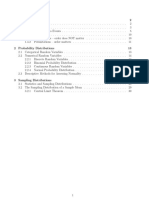0% found this document useful (0 votes)
8 views2 pagesProbability Guide Formatted
Probability is a mathematical field that measures the likelihood of events, ranging from 0 to 1. It includes various types such as classical, empirical, subjective, and axiomatic probability, along with key rules like the addition and multiplication rules. Applications of probability span multiple fields including statistics, machine learning, and finance.
Uploaded by
ruacheloim0Copyright
© © All Rights Reserved
We take content rights seriously. If you suspect this is your content, claim it here.
Available Formats
Download as PDF, TXT or read online on Scribd
0% found this document useful (0 votes)
8 views2 pagesProbability Guide Formatted
Probability is a mathematical field that measures the likelihood of events, ranging from 0 to 1. It includes various types such as classical, empirical, subjective, and axiomatic probability, along with key rules like the addition and multiplication rules. Applications of probability span multiple fields including statistics, machine learning, and finance.
Uploaded by
ruacheloim0Copyright
© © All Rights Reserved
We take content rights seriously. If you suspect this is your content, claim it here.
Available Formats
Download as PDF, TXT or read online on Scribd
/ 2


















































